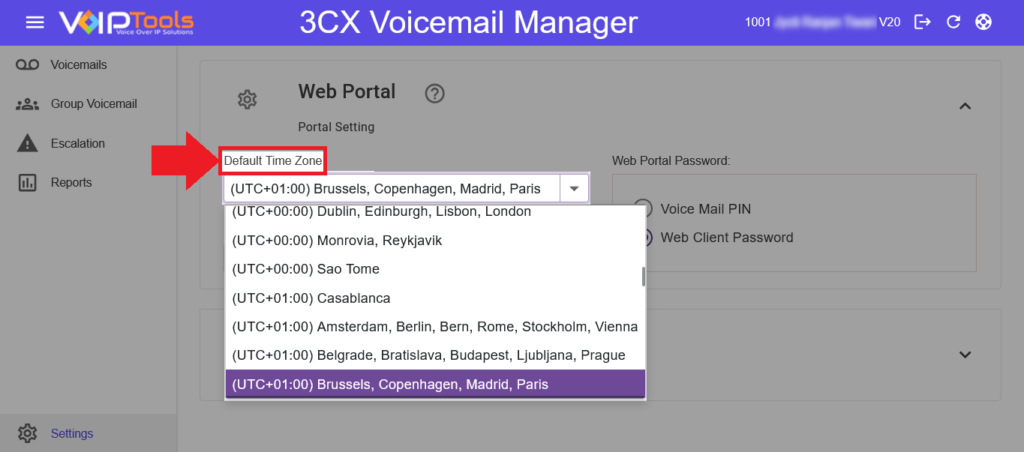Introduction #
Revolutionize Your Voicemail Management with Our Powerful Web Portal
Transform your voicemail management with our advanced web portal. Access your voicemails from anywhere, enjoying unparalleled flexibility and eliminating limitations. Our 3CX Voicemail Manager introduces exciting features that enhance the capabilities of 3CX. Experience the convenience of viewing your voicemails as text through automated transcription and email delivery.
Navigate through our user-friendly web portal, effortlessly searching and filtering your voicemail text using the built-in query manager. Take control by securely archiving your transcriptions in an SQL database and automatically removing old voicemails with a retention policy.
Never miss an important voicemail again with our ‘Escalation’ feature. Ensure no message goes unheard, keeping you on top of your communication. Simplify collaboration by easily sharing voicemails with your team or designated groups using our ‘Distribution’ feature, streamlining your communication channels.
Upgrade your voicemail management today and seize full control of your voicemails. Embrace flexibility, convenience, and efficiency with our powerful web portal and enhanced features. Say goodbye to outdated methods and embrace the future of voicemail management. Try it now and revolutionize the way you handle your voicemails!
What is 3CX Voicemail Manager? #
With the 3CX Voicemail Manager, you gain the ability to swiftly distribute voicemails to specific groups. Plus, you can easily escalate unanswered voicemails to designated email addresses through a designated extension group. Experience the efficiency of receiving text transcriptions for your voicemails. Enjoy optimized storage space as you compress and archive your voicemails. Effortlessly filter your voicemails using the built-in query manager, ensuring you find what you need quickly. And with the user-friendly web portal, accessing your voicemails remotely becomes a breeze. Upgrade your voicemail management today and streamline your communication processes.
Why choose 3CX Voicemail Manager? #
 | WEB-BASED APPLICATION | Retrieve and manage your voicemails effortlessly with our user-friendly web portal. Access your voicemails from anywhere and streamline your workflow. With our intuitive interface, you can easily search, listen to, forward, delete, and email voicemails. |
 | ENHANCED PRIVACY | Experience the convenience and privacy of reading your voicemails as transcribed text, automatically delivered to your email. Enjoy the discretion of communicating without listening to voicemails aloud. |
 | EFFICIENT ORGANIZATION | Effortlessly search and filter through the text of your voicemails using our integrated query manager, saving you valuable time and streamlining the process of locating specific messages. |
 | SECURE ARCHIVING | Store your voicemail transcriptions securely and retrieve them with ease using our reliable SQL database. Enjoy the peace of mind of knowing that your important messages are safely archived and readily accessible whenever you need them |
 | AUTOMATIC DELETION | Optimize your voicemail inbox and storage space by setting up a retention policy that automatically deletes old voicemails, ensuring a clutter-free environment. |
 | ESCALATION FEATURES | Experience peace of mind knowing that no critical voicemail will go unheard with our innovative ‘Escalation’ feature, guaranteeing prompt response times and eliminating communication gaps. |
 | STREAMLINED COLLABORATION | Foster efficient communication and collaboration within your team by effortlessly distributing voicemails to designated groups using the ‘Distribution’ feature. |
 | UNMISSED CRITICAL MESSAGES | Ensure uninterrupted communication by staying on top of critical messages with the voicemail escalation feature of the 3CX Voicemail Manager. Even when your staff is unavailable or taking time off, this feature guarantees that important voicemails are promptly addressed. Stay connected and never miss a crucial message again. |
Prerequisites #
Before you begin with the installation steps mentioned in this guide, you need to ensure that your computer meets the minimum requirements mentioned below for installing 3CX Voicemail Manager:
| PREREQUISITE | PURPOSE |
|---|---|
| 3CX Version V20 | 3CX Voicemail Manager is designed to work seamlessly with this version for enhanced features and performance. |
| Windows 10 or above / Windows Server 2016 / 2019 (64-bit) or above | These operating systems provide the necessary environment for the application to run efficiently. |
| IIS Features and Configuration – VoIPTools | IIS is needed as a web server to host and manage web-based applications and services. |
| .NET Framework 4.7.2 (Web Installer) | This framework provides essential components for running and developing applications. |
| VoIPTools Universal Updater | This component is necessary for updates, ensuring the application remains current and functional. |
| VoIPTools Relay Service | It is used for proper integration and functionality of the 3CX Voicemail Manager within the 3CX environment. |
| Microsoft SQL Server 2016 or above (Including the free SQL Express edition) | 3CX requires Microsoft SQL Server 2016 or later for database management. |
| Static IP for VoIPTools and 3CX servers | This is to ensure proper two-way communication, both the 3CX server (Relay) and the VoIPTools server. Dynamically assigned IP addresses are not supported. Additionally, it is recommended to use HTTPS for secure communication, which requires a FQDN for SSL/TLS certificate validation between the VoIPTools server and the Relay. |
| Port number 5650 opened on your device | Port 5650 is a specific network port used by 3CX for communication purposes. Opening this port on the device’s firewall allows incoming and outgoing traffic to pass through, enabling the 3CX software to send and receive data over the network effectively. |
| Google Cloud Account | Integrating Google Cloud’s Speech Translate service for voicemail transcription enables automatic transcription of voicemails into text format. |
NOTE:
- Our installers will offer to install Microsoft SQL Server, SQL Management Studio, Microsoft Internet Information Server (IIS), and Microsoft .Net Framework. If you have the installer perform these installs, all the needed settings will be configured automatically.
- If you choose to install SQL yourself, we recommend you install it in “Mixed Mode” to include SQL Authentication,
- If you choose to install IIS yourself, be sure to install Basic Authentication, .Net Extensibility, and ASP.Net 4.X
Installation overview #
 | DOWNLOAD SOFTWARE | You can order 3CX Voicemail Manager online at https://www.voiptools.com. Your order confirmation email will include your license key and a link to download the software. |
 | INSTALL PREREQUISITES | You must install several prerequisites before installing the 3CX Voicemail Manager. The Advanced Installer identifies and installs these applications automatically. Click here to learn about the required prerequisites. |
 | INSTALL 3CX VOICEMAIL MANAGER | This User Guide contains step-by-step instructions to successfully install 3CX Voicemail Manager. Begin by extracting the installer from the downloaded zip file (Step 1 above), then run the setup program named VoicemailManagerInstaller.exe |
 | LOGIN TO THE WEB APPLICATION | You can now log in to your software using the Extension and PIN. |
Step By Step Installation Procedure #
The following section guides you through a detailed walk-through of the installation process:
Step 1: Download 3CX Voicemail Manager #
Find the software download link in the Order Confirmation Email, or you can download the application by following the procedure,
- Open your browser and go to the VoIPTools official website or click here to get redirected to the website.
- Search for the Voicemail Application and click the Download
 button to download your application.
button to download your application.
Step 2: Install Prerequisites #
Click on the software installer downloaded in Step 1. The installation wizard will automatically identify the prerequisites and assist you with each installation required to 3CX Power Dialer. It includes .NET Framework (Web Installer), SQL Server Express (Web Installer), and SQL Server Management Studio.
- Click the downloaded installer executable to launch the Prerequisites Setup Wizard and click Next.

- In the Prerequisites window, install all the required prerequisites identified by the installer, or select/ unselect the applications based on your requirements and click Next to continue.
NOTE:
The installer will identify any prerequisites needed. It is recommended that you allow the installer to automatically install and configure the required prerequisites. Once all the prerequisites are installed, you can continue with the tool install.
- In the Microsoft SQL Server License Terms click the Accept button to acknowledge the license terms and continue.
- This page appears if you do not have SQL Server Express preinstalled in your device.

- View the SQL Server Media target location in the Media Location field. If required, you can click the Browse button to change the location. Click Install to begin the installation of SQL Server Express.

SQL server installation is in progress. This may take several minutes to complete.

- Click the Close button once the prerequisites are installed.

- Click Yes in the Confirmation Message Box to reboot the computer.

Step 3: Install 3CX Voicemail Manager #
- On the Welcome screen, click Next to start installing 3CX Voicemail Manager.

- On the Installation Folder window, the Folder field displays the location where the ‘3CX Voicemail Manager’ will be installed.
- Click Next to continue with the installation.
NOTE:
You cannot change the installation folder

Step 4: Test Relay Settings #
- In the 3CX Relay Services window, in the Relay Host field, enter the FQDN of your 3CX server.
NOTE:
Do not include https:// to the Relay host data.
- Enter 8801 in the Relay Port field.
- Enter the public key you copied from VoIPTools Relay services in the Public Key text area.

- Click the Test Relay Settings to confirm 3CX Voicemail Manager can communicate with the Relay services running on the 3CX server.
- If the 3CX Voicemail Manager is successfully able to communicate with the Relay services that run on the 3CX server, a Success message box appears. Click OK. If the test fails, you will not be able to continue until communication with the relay is established.
- Click Next to continue with the installation.
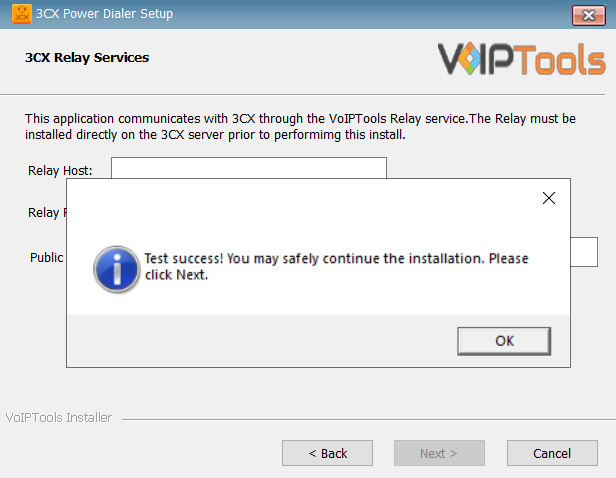
NOTE:
- You must set the Relay Port to 8801.
- If the Relay test fails, you cannot continue the installation until you establish communication with the Relay. If the test was unsuccessful:
- Confirm you have the correct firewall port open (default TCP 8801) on the 3CX server and the firewall protecting the 3CX server.
- Confirm that you have entered the correct FQDN for the 3CX server.
- Confirm that the 3CX Power Dialer and Relay use the same port and protocol.
Step 5: Configure the database #
When configuring the 3CX Voicemail Manager, select an existing Microsoft SQL Server instance in your environment. The database server can be a remote SQL Server, or a local instance running on the VoIPTools server.
You can set up the SQL database using SQL Authentication or Windows Integrated Authentication.
SQL Authentication #
- Enter your server name in the Server field.
- If using the free SQL Express Edition, the default SQL Instance name is SQLExpress.

NOTE:
- If you want to use ‘SQL Authentication’, then install SQL Server in ‘Mixed‘ mode.
- If SQL Server is installed on a server other than the server where 3CX Exporter is installed, you will need to configure SQL Server to allow remote connections.
- Enter your credentials in the Username and Password fields.

NOTE:
Make sure that you select a SQL Login that has sufficient permissions to alter the database and create SQL objects.
- Select or enter the 3CX Emergency Notifier in the Database dropdown.

- In the Test SQL Connections section, click the Tool button to test the connection and click OK in the Test Results popup box.

Windows Integrated Authentication #
- To use Windows Integrated Authentication check the Trusted Connection (Windows integrated authentication) checkbox.
- The VoIPTools installer will create a local Windows user name as “VoIPToys” and give you sufficient rights to this user to create/update the SQL database.

- In the Test SQL Connection section, click the Tool button to test the connection.
- Click the Next button which gets enabled when the database connection is successful.
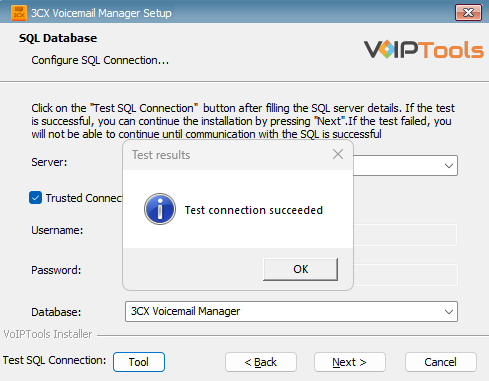
NOTE:
We encourage you to use SQL Authentication rather than Windows authentication. Many of our tools leverage a Call Flow Designer (CFD) application running on the 3CX. Frequently our CFD applications require access to a SQL database. If the 3CX server and the database server are not in an Active Directory domain, Windows authentication will fail. To use SQL authentication, your SQL Server must be configured to run in “Mixed Mode”. If you installed SQL Server with one of our tools, we configure SQL in “Mixed Mode”.
Step 6: Installing 3CX Voicemail Manager #
- On the Ready to Install screen, press Install to install 3CX Voicemail Manager

The 3CX Voicemail Manager installation is in process. This may take several minutes to complete.

- Click Finish to complete the installation .

Step 7: Login to the Web Application #
Follow the procedure to log in to your software,
- Double-click 3CX Voicemail Manager icon on your desktop to open the web application.
- In the Login page, do the following
- In the Extension field, enter your 3CX extension number.
- In the PIN field, enter your 3CX voicemail PIN.
- Click the Login button to log in to your account.

Manager View #
As a manager, you can access all the menu items of Voicemail Manager. You can also view the voicemails of the members of your department.

Agent View #
As an agent, you can access all the menus of Voicemail Manager. You can only view your voicemails.

Getting Started with Voicemail Manager Web Application #
This section provides a comprehensive overview of the web application, detailing its main features, layout, and functionality. It includes a description of each available menu item, helping you navigate the application efficiently and understand the tools and options at your disposal.
Overview of the Web Application #

 | Left Side Panel | It consists of all the menu items of the web application. |
 | Left Side Panel View Options | You can either expand or minimize the menu items. |
 | Web Application Logo | This is the default logo. You can customize the logo in the Settings menu. |
 | Web Application Title | This is the default title. You can customize the title in the Settings menu |
 | User Details | You can view the details of the user. It includes the extension number and the username. |
 | Logout Icon | Click the logout icon to log out from the web application. |
 | Restart Icon | Click the Restart icon to restart the web application. |
 | Support Resources Icon | Click the Support Resources icon to open the Support Resources popup. |
Left Side Panel – View Options #
The Left Side Panel consists of all the menus of the web application. You can minimize the Left Side Panel to enlarge your main content.


Support Resources Popup #
This popup provides you with essential support resources for the 3CX Voicemail Manager. It includes the version number (20.0.2), contact email, live chat link, and phone number. This information ensures you can access technical support and assistance whenever needed.

A Brief about Voicemail Manager Menu Items #
| Voicemail menu | The Voicemail menu enables you to manage, listen, forward, email, transcribe, and verify voicemail recordings for streamlined communication. | |
| Group Voicemail menu | The Group Voicemail menu enables shared voicemail boxes, distributing messages and updating status across designated group extensions. | |
 | Escalation menu | The Escalation feature forwards unheard voicemails to designated emails, ensuring critical messages are addressed promptly, even during unavailability. |
 | Reports menu | The Reports menu lets you view, organize, and export voicemail activity, ensuring efficient data management and streamlined analysis. |
 | Settings menu | The Settings Menu streamlines voicemail management with access controls, email integration, retention policies, AI features, and customization tools. |
Settings Menu #
The Settings Menu in 3CX Voicemail Manager centralizes configuration options to enhance system efficiency and customization. It includes settings for voicemail access, permissions, and data import to ensure secure and streamlined management. Features like email integration, retention policies, and voicemail escalation improve communication and optimize storage. Open AI and branding options provide advanced transcription, analysis, and application personalization. With web portal customization and authentication controls, the menu offers comprehensive tools for tailored and efficient system management.

| Voicemail Access and Permissions settings | The Voicemail Access and Permission Settings ensure secure voicemail access by assigning permissions based on departmental roles and responsibilities. | |
| Import Voicemails Data settings | The Import Voicemails Data settings allow seamless integration of older voicemails into the system for centralized management and archiving. | |
| Email settings | The Email Settings enable automated voicemail notifications and transcripts via email, ensuring timely communication through email server integration. | |
| Retention settings | The Retention Settings optimize disk space and storage by automating voicemail deletion, email cleanup, and archiving in compressed formats. | |
| Open AI settings | The Open AI Settings enable API integration, transcription management, and prompt customization for efficient transcription analysis and agent evaluation. | |
| Voicemail Escalation settings | The Voicemail Escalation Settings escalate unheard voicemails to emails and support group distribution, ensuring timely responses and communication. | |
| Web Portal settings | The Web Portal Settings enable efficient voicemail management, time zone customization, display culture preferences, and secure authentication options. | |
| Custom Branding settings | The Custom Branding Settings allow you to personalize your application’s appearance, including titles, logos, and color schemes, ensuring brand alignment. |
Voicemail Access and Permission Settings #
The Voicemail Access and Permission settings simplifies access to voicemail recordings by restricting permissions based on departmental roles. Department managers can access their own recordings as well as those of their team members, while users with the “User” role can only access their personal recordings.
Assign Manager Rights for an Extension #
This section guides you to assign managerial rights to an extension for the departments where the extension is present.
Before you Start: Navigate to the Voicemail Access and Permission Settings under the Settings menu.
- Click to expand the Manage Department Extensions section.

- Select the department from the Select Department dropdown.

- Select the extensions from the Voicemail Managers list.

Result: The selected extensions get assigned as managers of their respective departments.
Permit Managers to Export Voicemail #
This section guides you give access to the managers of the departments to view the voicemails of their department members.
Before you Start: Navigate to the Voicemail Access and Permission Settings under the Settings menu.
- Click to expand the Manager Rights Management section.

- Select the Allow Managers to Access Department Members Voicemails box.

Results: The managers can now access the voicemails of their department members.
Import Voicemail Data Settings #
The Import Voicemails Data settings lets you add pre-existing voicemails to the system’s SQL database and archive them if the archive option is enabled in the Retention settings. It facilitates seamless integration of older voicemails into the web portal for centralized management.
Before you Start: Navigate to the Import Voicemail Data Settings under the Settings menu.
NOTE:
If you have a large number of existing voicemails, import after the normal business hours. Processing a large number of voicemails may impact the performance of 3CX.
- Click the Import button to add the pre-existing voicemails to SQL and archive.
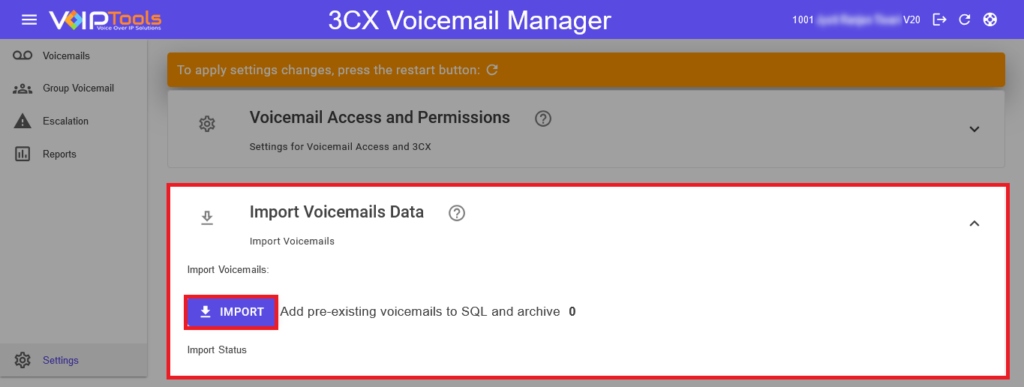
Results: Pre-existing voicemails is now added to the SQL and archived.

Email Settings #
The Email Settings feature allows you to configure the system to email voicemail notifications, including optional text transcripts, to designated recipients. It enables integration with an email server for automated delivery of voicemail details, ensuring timely and efficient communication for users managing their voicemail messages.
Auto Email the Voicemail Notifications #
This section guides you to mail your voicemails, along with a text transcript automatically.
Before you Start: Navigate to the Email Settings under the Settings menu.
- Check the Email Voicemail Transcript check box.

- In the Email Server field, enter the IP address or ‘Fully Qualified Domain Name (FQDN) of your email server.
- In the Port field, enter the port number.
- The default value is 25.
- For Gmail/ Google Apps use port 587
- In the Email From field, enter the email address to use as the “from” email address.
- Note that your SMTP server may require a valid email address be used.
- For example no-reply@mydomain.com
- In the Email Subject field, enter the email subject.
- The default subject is “New Voicemail from [CALLERID], [DATE], [TIME]”.
- You can include any of the 3 available replaceable variables [CALLERID],[DATE] or [TIME]. Placing these exact string variables in the subject line will cause the variables to be replaced with the current caller information.
- In the Alt Email field, enter an email address (example: user@mydomain.com) if you want all voicemails sent to a single email address. To only have emails sent to the owner of the voicemail, leave this field blank.

- Check Requires Authentication check box if your mail server requires authentication to relay emails.
- Enter credentials in the User ID and Password fields.

- Select the Requires TLS box if your mail server requires Transport Layer Security (TLS) to relay email. Gmail, Google Apps, and Microsoft 365 require a secure connection.

- Click the Test button to confirm whether 3CX Voicemail Manager can send emails.

- In the Email Test popup,
- Enter a sender email in the Email From field.
- Enter a receiver email in the Email To field.
- Click the Send button.

Results: A success popup indicates that you have successfully configured auto email of the voicemails.

Convert Voicemails to MP3 Files #
The Voicemail to Email feature converts voicemails to a smaller .MP3 format and emails them, enabling efficient storage, quick access, and seamless communication for users.
Before you Start: Navigate to the Email Settings under the Settings menu and have setup auto email of your voicemail notifications.
- Select the Attach Voicemail Using MP3 Format.

Results: Voicemails audio files is now converted to .MP3 file and gets attached in the voicemail notification email.
Retention Settings #
The Retention Settings feature manages the automatic deletion, conversion, and archiving of voicemails to optimize disk space usage and streamline voicemail storage. It thus, helps you conserve disk space by automatically deleting old voicemails or voicemails sent via email. It enables archiving voicemails in compressed .MP3 format at a specified location, ensuring efficient storage and long-term accessibility. These settings enhance system performance, prevent storage overflow, and provide flexibility in managing voicemail retention policies.
Delete Policy #
The Delete Policy section allows you to manage voicemail storage by automatically deleting old voicemails or voicemails sent via email. It ensures efficient use of disk space and helps maintain organized voicemail records. You can also delete associated database records to remove voicemail history from the web portal.
Delete Voicemail After Sending Email #
This section guides you to delete voicemails automatically after sending an email.
‘Warning
Exercise caution when selecting this option, as there is no assurance that the email will bypass spam filters or comply with the maximum attachment size limits set by the receiving mail server.
Before you Start: Navigate to the Retention Settings under the Settings menu.
- Click to expand the Delete Policy section.

- Select the Delete Voicemail After Sending Email box.

Results: The voicemails will not get deleted when the voicemail is sent as an attachment in the email.
Delete Voicemail Older than Particular Date #
This section guides you to configure the system to automatically delete voicemails after they reach a specified age.
Before you Start: Navigate to the Retention Settings under the Settings menu.
- Click to expand the Delete Policy section.
- Select the Delete Voicemail If Older Than box.
- Enter the number of days in the Days field.
- Select the time in the Delete At field.

Results: Voicemails older than the specified number of days will be deleted, based on the comparison between the current date and the voicemail creation date. This setting applies to all voicemails across all extensions.
Delete Voicemails from SQL Database #
This section guides you to configure the system to automatically delete voicemails from the SQL server with the current delete policy settings.
Before you Start: Navigate to the Retention Settings under the Settings menu and configured the Delete Policy settings.
- Click to expand the Delete Policy section.
- Select the Remove Voicemails from SQL based on Deletion settings box.

Results: The deleted voicemails also get deleted from SQL. Deleting the records from SQL will remove any history for the voicemails in the web portal.
Archive Policy #
The Archive Policy allows you to create compressed .MP3 copies of voicemails and store them in a specified location, independent of the Delete Policy. This ensures secure storage of voicemails while maintaining efficient disk space usage. Archived voicemails remain accessible and unaffected by automatic deletion settings.
This section guides you to configure the system to automatically archive voicemails to a specific location.
Before you Start: Navigate to the Retention Settings under the Settings menu.
- Click to expand the Archive Policy section.

- Check the Archive Path box to enable the archive policy.
- In the Archive Path field, enter the path to store all the archived voicemails.

Results: Archived voicemails get saved in .MP3 format in the specified path location and are NOT affected by the Delete Policy.
Open AI Settings #
The Open AI Settings serve to configure the API connection, manage call transcription preferences, and define specific AI prompts that guide the system in analyzing and scoring transcriptions. The ultimate goal is to enable intelligent analysis and automation of call transcription data, improving both operational efficiency and agent performance assessment.
Manage Open AI Account Settings #
This section guides you to configure the OpenAI API integration for transcription and analysis tasks.
Before you Start: Make sure you have navigated to the Open AI settings under the Settings menu and have valid Open AI credentials.
- Click to expand the AI Configuration section.

- Enter your AI model in the Open AI API Model field.
- Enter the URL endpoint for the Open AI API in the API Base Address field.
- Enter the unique key for authentication requests to the Open AI API in the API Key field.

- Click the Test button.

Results: Your Open AI credentials is validated, and you get a success popup when the validation is successful.

Manager AI User Transcription Settings #
The AI Transcription Analysis User Settings lets you manage call transcription preferences for individual or multiple extensions. They allow toggling transcription, applying settings across all extensions, and saving or canceling changes. These settings provide flexibility and control over how and when call transcriptions are performed and updated in the system.
This section guides you to manage call transcription preferences for individual or multiple extensions.
Before you Start: Make sure you have navigated to the Open AI settings under the Settings menu and have connected with the Open AI API.
- Click to expand the AI Transcription Analysis User Settings section.

- Select the extensions to whom you want to enable the feature.

- Click the Save All button.

Results: The AI now does the transcription analysis for the selected extensions.
Open AI Prompt Settings #
The Open AI Prompt Settings let you manage prompts that guide AI analysis of call transcriptions. You can create prompts to extract key details, summarize conversations, or evaluate agent performance. By categorizing prompts, you ensure accurate AI responses tailored for recording analysis or agent scoring, aligning outputs with your specific needs.
Add a New Prompt #
This section guides you to add a new AI prompt to use in the voicemails.
Before you Start: Make sure you have navigated to the Open AI settings under the Settings menu and have connected with the Open AI API.
- Click to expand the Open AI Prompts Settings section.

- Click the New button.

- Enter a name for the prompt in the Prompt Label field.
- Enter the AI prompt in the AI Prompt Text field.
- Select a icon for the prompt in the Prompt Icon dropdown.
- Read further sections to learn how to upload a prompt icon.

- Click the Save button.

Results: The new AI prompt is now added to the Open AI Prompts Settings.
Activate or Deactivate a Prompt #
This section guides you to activate or deactivate an AI prompt.
Before you Start: Make sure you have navigated to the Open AI settings under the Settings menu, have connected with the Open AI API and have pre-existing AI prompts.
- Click to expand the Open AI Prompts Settings section.
- Select the Active box of desired prompts.
- Click the Save button.

Results: The selected prompts get activated in Voicemail menu.
Add Icons to Prompt #
This section guides you to add icons to AI prompts.
Before you Start: Make sure you have navigated to the Open AI settings under the Settings menu, have connected with the Open AI API and have pre-existing AI prompts.
- Click to expand the Open AI Prompts Settings section.
- Click the Browse button and select desired icon from your device.
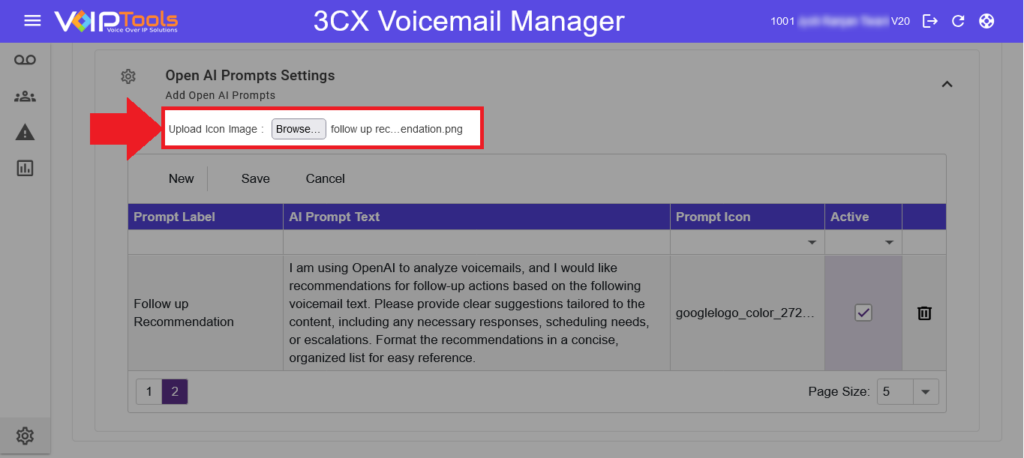
- Select the prompt icon from Prompt Icon dropdown.
- Click the Save button.

Results: The prompt icon gets added to the desired prompt text.
Delete an existing Prompt #
This section guides you to delete existing AI prompts.
Before you Start: Make sure you have navigated to the Open AI settings under the Settings menu, have connected with the Open AI API and have pre-existing AI prompts.
- Click to expand the Open AI Prompts Settings section.
- Click the Delete
 button.
button. - Click the Save button.

Results: The prompt icon gets deleted from the web application.
Voicemail Escalation Settings #
The Voicemail Escalation Settings ensure critical voicemails are addressed promptly by escalating unheard messages to designated email addresses. This feature monitors voicemail delays, prevents important messages from being overlooked, and supports group voicemail functionality by distributing voicemails to specified members, ensuring efficient communication and timely responses.
Set Waiting Period Before Processing New Voicemail #
This section guides you to set waiting period in seconds before processing a new voicemail.
Before you Start: Make sure you have navigated to the Voicemail Escalation settings under the Settings menu.
- Click to expand the Voicemail Escalation section.
- Set the delay period in the Escalation Delay field.

Results: Voicemail Manager waits for the set time before processing a new voicemail. This delay ensures the system has enough time to fully write and release the voicemail file to disk before attaching it to an escalation email.
Web Portal Settings #
The Web Portal Settings in the 3CX Voicemail Manager provide tools for managing voicemails efficiently. Users can search, listen to, download, email, forward, and delete voicemails via a query manager. These settings also allow customization of time zones and display cultures for accurate date/time and transcription language preferences. Additionally, authentication options enable users to select their preferred credential type (voicemail PIN, web client password, or phone authentication password) for secure and convenient access to the portal.
Set Time Zone for Web Application #
This section guides you to set the default time zone for the web application.
Before you Start: Make sure you have navigated to the Web Portal settings under the Settings menu.
- Click to expand the Web Portal settings.
- Select the desired time zone in the Default Time Zone dropdown.
Results: The selected time zone gets reflected in all the menus of the web application.
Set Display Culture for Web Application #
This section guides you to set the default display culture for the web application.
Before you Start: Make sure you have navigated to the Web Portal settings under the Settings menu.
- Click to expand the Web Portal settings.
- Select the desired language culture in the Display Culture dropdown.
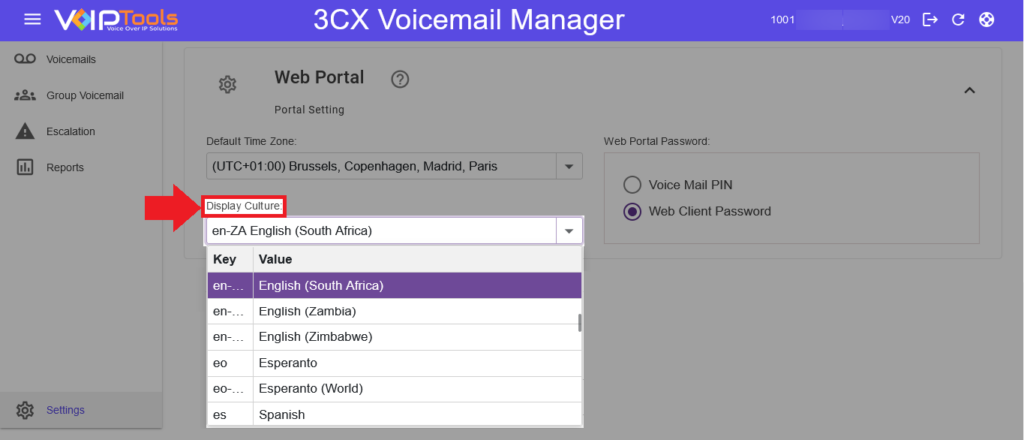
Results: The selected display culture gets reflected in all the menus of the web application.
Set Authentication Method #
This section guides you to set the authentication type for the web application.
Before you Start: Make sure you have navigated to the Web Portal settings under the Settings menu.
- Click to expand the Web Portal settings.
- Select the desired authentication type in the Web Portal Password section.
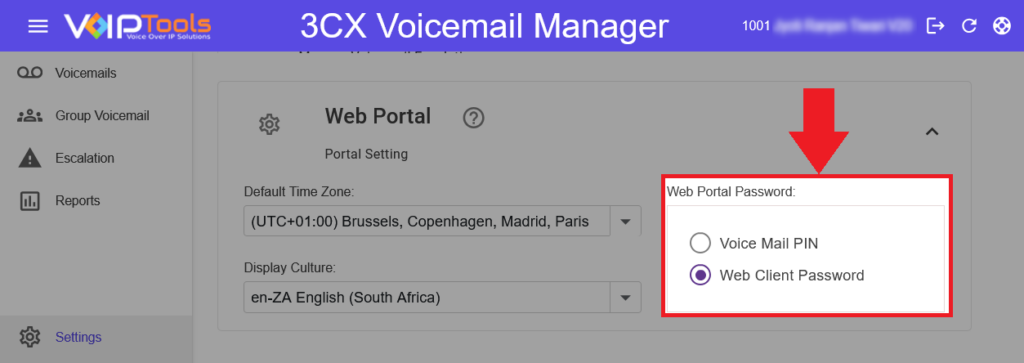
Results: The selected time zone gets reflected in all the menus of the web application.
Custom Branding Settings #
The Custom Branding Settings lets you customize the visual appearance of your application to align with your organization’s branding. You can specify a header title, upload a custom logo, and configure header gradient and grid background colors using intuitive tools. These options allow you to create a professional and cohesive design.
Customize Header Colour #
This section guides you to change the header gradient top and bottom colors.
Before you start, make sure you have logged into the application with the manager rights and navigated to the Site Settings screen, in the Settings menu dropdown.
- In the Header Gradient Color section, select the Top Color from the palette
- Select the Bottom Color from the palette.
- Click the Apply
 button to save your changes.
button to save your changes.
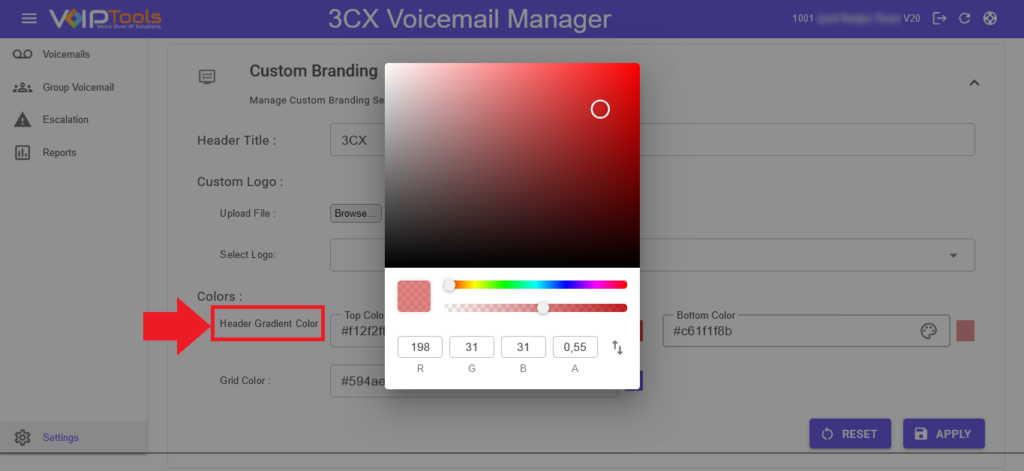
Results: You have customized the header gradient color of the application.

Customize Grid Colour #
This section guides you to change the grid color of the web application.
Before you start, make sure you have logged into the application with the manager rights and navigated to the Site Settings screen, in the Settings menu dropdown.
- Select the grid color from the Grid Color palette.
- Click the Apply
 button to save your changes.
button to save your changes.

Results: You have customized the grid color of the application.

Customize Website Logo #
This section guides you to upload or update custom logo to the web application.
Before you start, make sure you have logged into the application with the manager rights and navigated to the Site Settings screen, in the Settings menu dropdown.
- Click the Browse button and browse the desired logo in your device.

- Select the uploaded logo in the Custom Logo dropdown.
- Click Apply
 to save your changes.
to save your changes.

Results: Your logo gets updated to the website.

Customize Header Title Prefix #
This section guides you to change the prefix of the title header.
Before you start, make sure you have logged into the application with the manager rights and navigated to the Site Settings screen, in the Settings menu dropdown.
- Enter the title prefix in the Header Title field.
- Click the Apply
 button to save your changes.
button to save your changes.

Results: You have changed the prefix of the title header.

Voicemail Menu #
The Voicemail menu allows you to efficiently manage voicemail recordings within your organization. You can view, listen to, email, download, forward, or delete voicemails. The menu also enables transcription using AI, retrieval of deleted voicemails, and identification of tampered recordings for ensuring authenticity. With its user-friendly interface and advanced management features, the Voicemail menu streamlines communication by providing quick access to voicemail details, ensuring you maintain seamless connectivity and operational efficiency.
Voicemail Menu – Column Definitions #
| Column Name | Definition / Purpose |
|---|---|
| Ext | Extension number of the agent who made the call. |
| Caller Name | The name of the person who left the voicemail. |
| Caller | The phone number of the person who left the voicemail. |
| Duration | Length of the voicemail in HH:MM:SS format. |
| Created | The date and time when the voicemail was created in YYYY/MM/DD HH:MM:SS format |
| Notified | The date and time when the voicemail was notified to the agent in YYYY/MM/DD HH:MM:SS format |
| Heard | The date and time when the voicemail was heard by the agent in YYYY/MM/DD HH:MM:SS format |
| Deleted | The date and time when the voicemail was deleted by the agent in YYYY/MM/DD HH:MM:SS format |
View and Listen to a Voicemail #
This section guides you to view and listed to the voicemail audio files.
Before you Start: Make sure you have navigated to the Voicemail ![]() menu and have manager rights if you want to view the voicemails of agents of your department.
menu and have manager rights if you want to view the voicemails of agents of your department.
- Click the View
 icon of the desired voicemail to open Voicemail Details popup.
icon of the desired voicemail to open Voicemail Details popup. - Click the Play section in the left side panel.

Results: You can now play the Voicemail Audio or the Archive Audio using the inbuilt audio player.

Email Voicemail Recordings #
his section guides you to email the voicemail audio files.
Before you Start: Make sure you have navigated to the Voicemail ![]() menu and have manager rights if you want to email the voicemails of agents of your department.
menu and have manager rights if you want to email the voicemails of agents of your department.
- Click the View
 icon of the desired voicemail to open Voicemail Details popup.
icon of the desired voicemail to open Voicemail Details popup. - Click the Play section in the left side panel.
- Click the Email Voicemail button.

- Enter the email details in the Email Recording popup and click the Send button

Result: The voicemail gets emailed to the desired email address.
Download Voicemail Recordings #
This section guides you to download the voicemail audio files.
Before you Start: Make sure you have navigated to the Voicemail ![]() menu and have manager rights if you want to download the voicemails of agents of your department.
menu and have manager rights if you want to download the voicemails of agents of your department.
- Click the View
 icon of the desired voicemail to open Voicemail Details popup.
icon of the desired voicemail to open Voicemail Details popup. - Click the Play section in the left side panel.
- Click the Download Voicemail button.

Result: The voicemail gets downloaded to your local device.
Forward Voicemail to an Extension #
This section guides you to forward the voicemail to an extension with a CFD call on your logged-in extension
Before you Start: Make sure you have navigated to the Voicemail ![]() menu and have manager rights if you want to forward the voicemails of agents of your department.
menu and have manager rights if you want to forward the voicemails of agents of your department.
- Click the View
 icon of the desired voicemail to open Voicemail Details popup.
icon of the desired voicemail to open Voicemail Details popup. - Click the Forward Voicemail section in the left side panel.

- Select the extensions you want to forward the voicemail.

- You can click the Add Intro button to receive a CFD (Call Forwarding Diversion) call on your logged-in extension.
- Click the Forward button.

Results: The voicemail gets forwarded to the selected extensions with a CFD (Call Forwarding Diversion) call on your logged-in extension.

View Voicemail Transcription #
This section guides you to generate transcripts of voicemails using AI.
Before you Start: Make sure you have navigated to the Voicemail ![]() menu and have manager rights if you want to forward the voicemails of agents of your department. Also. ensure that you have connected with the Open AI API to use the AI transcription.
menu and have manager rights if you want to forward the voicemails of agents of your department. Also. ensure that you have connected with the Open AI API to use the AI transcription.
- Click the View
 icon of the desired voicemail to open Voicemail Details popup.
icon of the desired voicemail to open Voicemail Details popup. - Click the Transcription section in the left side panel.

- Click the Analyze button.

Results: The AI generates the transcription of the voicemail.

Delete Voicemails Manually #
This section guides you to delete voicemails manually. You can set auto delete of voicemails using the Delete Policy.
Before you Start: Make sure you have navigated to the Voicemail ![]() menu and have manager rights if you want to delete the voicemails of agents of your department.
menu and have manager rights if you want to delete the voicemails of agents of your department.
- Click the Delete
 icon of the desired voicemail.
icon of the desired voicemail.

- Click YES in the Delete Confirmation popup.

Result: The selected voicemails is deleted.

View Deleted Voicemails #
This section guides you to view the deleted voicemails.
Before you Start: Make sure you have navigated to the Voicemail ![]() menu and have manager rights if you want to view the deleted voicemails of agents of your department.
menu and have manager rights if you want to view the deleted voicemails of agents of your department.
- Select the Show Deleted Voicemails box.

Results: You can now view the deleted voicemails with the deletion dates.

Identify Tampered Recordings #
This section provides guidance on identifying tampered voicemail recordings.
To determine if a recording has been altered, 3CX Voicemail Manager compare the details of the recording in the 3CX Console Management with those in the Voicemail Manager web application. If the details match in both systems, the recording is considered authentic. If there are discrepancies, the recording may have been tampered with.
The following image represents a voicemail that is authentic and not tampered.
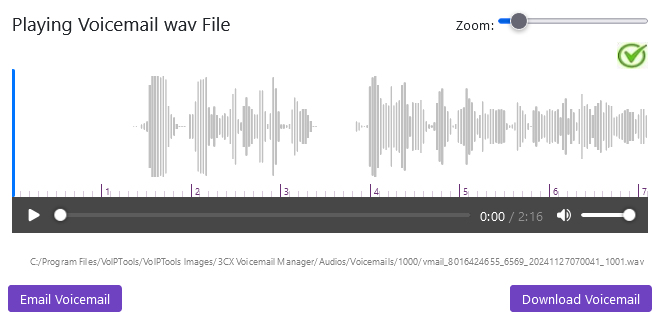
The following image represents a voicemail that is tampered.

Group Voicemail Menu #
The Group Voicemail menu simplifies the process of designating a standard 3CX voicemail box as a group voicemail box. When a voicemail is saved in a group voicemail box, it is automatically distributed to the extensions listed in the distribution group. If any extension within the group listens to the voicemail, the HEARD date and time will be updated for all extensions in the group. This functionality proves useful when the company CEO wants to send a voicemail message to all employees or when a manager wishes to communicate with everyone in their specific group.
Create a Group Voicemail / Distribution Group #
This section guides you to create a new group voicemail.
Before you Start: Make sure you have navigated to the Group Voicemail menu in the left side panel.
- Click the Add
 icon.
icon.

- Select the desired group from the Voicemail Box dropdown.

- Enter the name of the group in the Name field.
- Enter a short description of the group in the Description field.
- Select the members of this group from the Members dropdown.
- Click the Save button.

Results: The new group voicemail is created.

NOTE:
When a voicemail is saved in a group voicemail box, it is marked as “heard” only for the member who listens to it. For all other group members, the voicemail remains marked as “unheard.”
Example:
If a group includes members A, B, and C, and a voicemail is received in the group voicemail box, it will initially appear as “unheard” for all members. When A listens to the voicemail, it is marked as “heard” in A ‘s Voicemail Menu and Reports Menu, while it remains “unheard” for B and C.
Edit a Group Voicemail / Distribution Group #
This section guides you to edit an existing group voicemail.
Before you Start: Make sure you have navigated to the Group Voicemail menu in the left side panel and have existing group voicemails to edit.
- Click the Edit
 icon.
icon.

- In the Group Settings popup do the changes.
- Click the Save button.
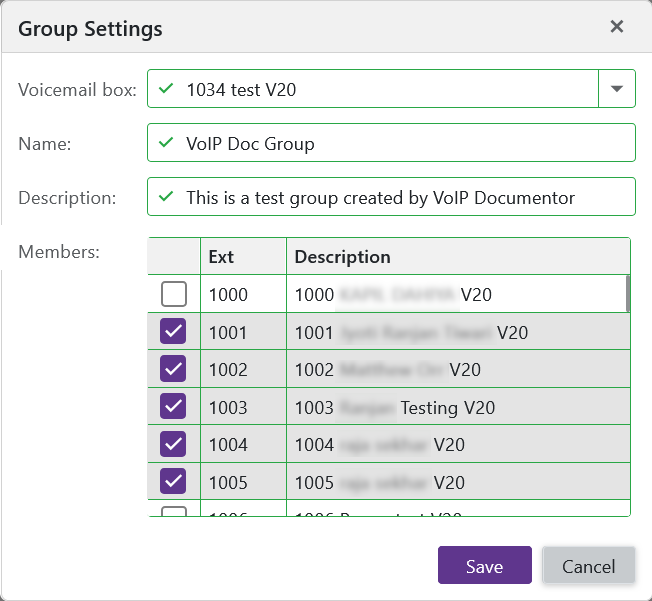
Results: The group voicemail is configured.
Delete a Group Voicemail / Distribution Group #
This section guides you to delete an existing group voicemail.
Before you Start: Make sure you have navigated to the Group Voicemail menu in the left side panel.
- Click the Delete
 icon.
icon.

- Click Yes in the Delete Confirmation popup.

Results: The desired group voicemail is deleted.
Escalation Menu #
The Escalation feature ensures critical voicemails are promptly addressed by automatically forwarding unheard messages to designated email addresses. For instance, sales voicemails can be escalated to a sales manager when a salesperson is unavailable. To use this feature, create a “Sales” extension group in 3CX, assign the relevant sales extensions to the group, and configure the group for escalation. The system will monitor voicemails for any extensions in the group, and if an unheard voicemail is detected, it will be automatically escalated to the specified email recipients.
Add New Escalation #
This section guides you to add a new escalation that escalates unheard voicemails to the senior management.
Before you Start: Make sure you have navigated to the Escalation menu in the left side panel.
- Click the Add button.

- In the Extension Group dropdown, select the extension group that you want to monitor.

- In the Expire field, enter the time in minutes.

- In the Emails text box, enter one or more email addresses separated by commas, to which you want to mail the escalated voicemail.

Results: Any unheard voicemails now get escalated to the mail ID provided in the Escalation menu.
Delete Existing Escalation #
This section guides you to delete existing escalations in the Escalation menu.
Before you Start: Make sure you have navigated to the Escalation menu in the left side panel.
- Click the Delete
 icon.
icon.

- Click Yes in the Delete Confirmation popup.

Results: The desired escalation is deleted.
Reports Menu #
The Reports menu provides you with a comprehensive overview of voicemail activity, including caller details, voicemail duration, and timestamps for creation, notification, hearing, and deletion. It allows you to group columns for better organization and export reports in various formats, ensuring efficient analysis and sharing of voicemail data.
Column Definitions of Reports Menu #
| Column Name | Definition / Purpose |
|---|---|
| Caller Name | Name of the caller who made the call. |
| Ext | Extension number of the caller. |
| Caller | The phone number of the caller. |
| Duration | The duration of the voicemail in HH:MM:SS format. |
| Flags | |
| Created | Date and time at which the voicemail is created. The date format is YYYY-MM-DD. The time format is 12 hours clock with HH:MM:SS. |
| Heard | Date and time at which the voicemail is heard. The date format is YYYY-MM-DD. The time format is 12 hours clock with HH:MM:SS. |
| Notified | Date and time at which the voicemail is notified. The date format is YYYY-MM-DD. The time format is 12 hours clock with HH:MM:SS. |
| Deleted | Date and time at which the voicemail is deleted. The date format is YYYY-MM-DD. The time format is 12 hours clock with HH:MM:SS. |
| FileName | File name of the voicemail. |
| Voicemail | The AI generated transcription of the voicemail. |
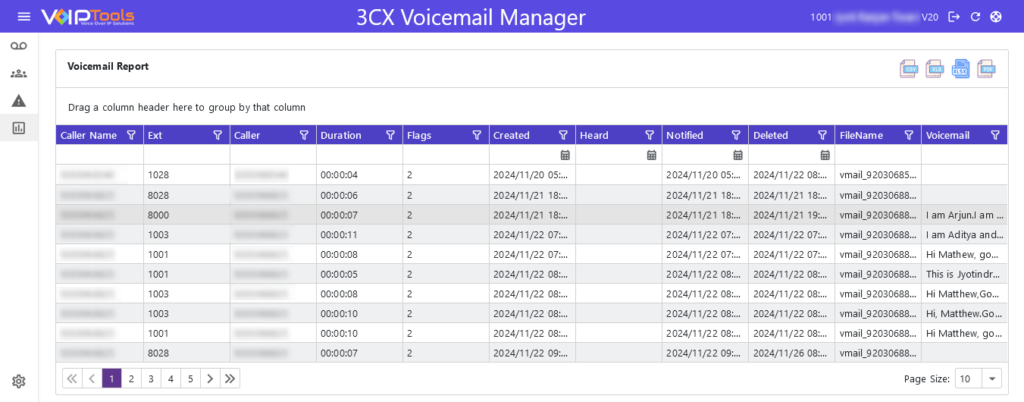
Group the Columns in Reports Menu #
The grouping of columns lets you present the reports more professionally and helps you achieve a well-organized and polished look for the information displayed.
This section guides you to group the columns in the Reports menu,
Before you Start: Make sure you have navigated to the Reports menu in the left side panel.
- Drag and drop the desired column to the space provided above the column headers.

- Click the Expand icon to expand the grouped columns

Export Voicemail Reports #
This section guides you to export the voicemail reports to your local device.
Before you Start: Make sure you have navigated to the Reports menu in the left side panel.
- Click the desired export option. Available export options are CSV, PDF, XLS and XLSX.

Need Support? #
You get quick answers to most of your inquiries in our online manual. If you prefer direct contact, we offer various support channels, including phone, email, live chat, and our helpful VoIPTools forums.

24/7 Support Availability #
Rest assured, our dedicated team is here to assist you around the clock, every day of the year. Whether you’re based in the USA or India, we’re ready to provide prompt responses to your technical queries.

Windows Event Log for VoIPTools Applications and Services #
For troubleshooting any application errors, our Windows Event Log contains a comprehensive list of error messages, warnings, and informative notes related to all our VoIPTools applications and services. It’s a valuable resource to help you pinpoint and resolve any issues you may encounter.

Join Our Forum Community #
Are you looking to collaborate with other VoIPTools customers facing similar challenges? Our forum is the perfect platform to exchange ideas, solutions, and best practices. Join the conversation at: https://www.voiptools.com/community/

Real-Time Live Chat Assistance #
Got questions that need immediate answers? Our chat support team is available to assist you in real time. Just click on the Live Chat button located at the lower right corner of our website, and we’ll acknowledge your queries right away.

Efficient Email Support #
To ensure a thorough understanding of your concerns, email us at support@voiptools.com. Describe your issue in detail, and we’ll get back to you within one business day with the support you need.

Reach Us by Phone #
If you prefer to speak with a representative directly, you can reach us at +1 801-642-4655. Our attentive team is available to take your calls from 8:00 AM to 6:00 PM (Central Standard Time).
Comprehensive support services: #

Free Support #
If you’ve purchased our products through a VoIPTools Partner, rest assured that they provide first-level support at no additional cost. Partners have access to 100% free technical assistance and actively participate in the troubleshooting process.
VoIPTools customers enjoy access to our online manuals and receive support through emails (with responses within one business day) and live chat. However, please note that we do not provide remote server login assistance.

Paid Support #
For a more hands-on experience, consider our “Installation Support” package. Our expert support team can log in to your servers, and install and configure all our tools. This comprehensive service includes setting up SQL Server Express and Internet Information Server if necessary. We’ll work closely with you to tailor our applications to meet your requirements.
We’re committed to providing top-notch support to ensure your VoIPTools experience is smooth and hassle-free. Contact us today, and let us assist you in making the most of our powerful tools!

